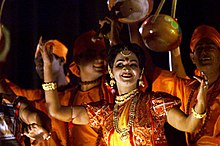 | ||||||
| Music of Bangladesh | ||||||
| Genres | ||||||
|---|---|---|---|---|---|---|
| Specific forms | ||||||
|
||||||
| Media and performance | ||||||
|
||||||
| Nationalistic and patriotic songs | ||||||
|
||||||
| Regional music | ||||||
|
||||||
Ghatu, Ghetu Gaan, or Ghetu Song is a type traditional cultural song of the Eastern Part of the Bangladesh. [1] The songs were traditionally sung during the monsoon season, [1] though the tradition is on the decline. [2] The festival was mainly held in north-eastern side of Mymensingh and lower part of Sylhet in Bangladesh. [3]
The first day of Bhadro (5th month of Bengali calendar) started on the eve of Bisharjan of Manasha ( Bengali: মনসার ভাসান) [1] and later celebrated on the day of Vijaya Dashami during the monsoon season. [3]
The festival revolves around a teenage boy. The boy dresses in shari and grows out his hair, with the intent of resembling a girl. [3] The very young boys were sexually abused and that contributed to the decline of this form of music. [4] During the festival he plays the role of pantomime by dancing or otherwise representing the Ghatu song. The Ghatu songs are mainly oriented around Radha Krishna. [3]
- The film Ghetuputra Komola by Humayun Ahmed was based on the life of a young Ghatu Singer. [5]
- ^ a b c Varot kosh 3rd part (ভারত কোষ) (in Bengali). Kolkata: Bongiyo Sahityo Porishod. p. 275.
- ^ Afsaruddin, Mohammad (1990). Society and Culture in Bangladesh. Book House. p. 141.
- ^
a
b
c
d Bhattacharya, Asutosh (1962). Banglar Loko Sahityo (in Bengali). Kolkata.
{{ cite book}}: CS1 maint: location missing publisher ( link) - ^ "::: Star Weekend Magazine ::". www.thedailystar.net. Retrieved 2018-02-06.
- ^ "Ghetu Putro Kamola". The Daily Star. 2012-09-07. Retrieved 2018-02-06.
 | ||||||
| Music of Bangladesh | ||||||
| Genres | ||||||
|---|---|---|---|---|---|---|
| Specific forms | ||||||
|
||||||
| Media and performance | ||||||
|
||||||
| Nationalistic and patriotic songs | ||||||
|
||||||
| Regional music | ||||||
|
||||||
Ghatu, Ghetu Gaan, or Ghetu Song is a type traditional cultural song of the Eastern Part of the Bangladesh. [1] The songs were traditionally sung during the monsoon season, [1] though the tradition is on the decline. [2] The festival was mainly held in north-eastern side of Mymensingh and lower part of Sylhet in Bangladesh. [3]
The first day of Bhadro (5th month of Bengali calendar) started on the eve of Bisharjan of Manasha ( Bengali: মনসার ভাসান) [1] and later celebrated on the day of Vijaya Dashami during the monsoon season. [3]
The festival revolves around a teenage boy. The boy dresses in shari and grows out his hair, with the intent of resembling a girl. [3] The very young boys were sexually abused and that contributed to the decline of this form of music. [4] During the festival he plays the role of pantomime by dancing or otherwise representing the Ghatu song. The Ghatu songs are mainly oriented around Radha Krishna. [3]
- The film Ghetuputra Komola by Humayun Ahmed was based on the life of a young Ghatu Singer. [5]
- ^ a b c Varot kosh 3rd part (ভারত কোষ) (in Bengali). Kolkata: Bongiyo Sahityo Porishod. p. 275.
- ^ Afsaruddin, Mohammad (1990). Society and Culture in Bangladesh. Book House. p. 141.
- ^
a
b
c
d Bhattacharya, Asutosh (1962). Banglar Loko Sahityo (in Bengali). Kolkata.
{{ cite book}}: CS1 maint: location missing publisher ( link) - ^ "::: Star Weekend Magazine ::". www.thedailystar.net. Retrieved 2018-02-06.
- ^ "Ghetu Putro Kamola". The Daily Star. 2012-09-07. Retrieved 2018-02-06.
